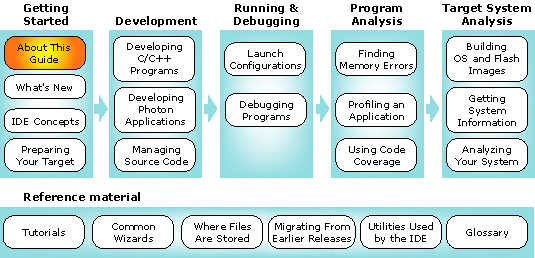![[Previous]](prev.gif) |
![[Contents]](contents.gif) |
![[Index]](keyword_index.gif) |
![[Next]](next.gif) |
![[Previous]](prev.gif) |
![[Contents]](contents.gif) |
![[Index]](keyword_index.gif) |
![[Next]](next.gif) |
 |
This version of this document is no longer maintained. For the latest documentation, see http://www.qnx.com/developers/docs. |
You can select a topic from this diagram:

The IDE User's Guide at a glance.
This User's Guide describes the Integrated Development Environment (IDE), which is part of the QNX Momentics development suite. The guide introduces you to the IDE and shows you how to use it effectively to build your QNX Neutrino-based systems.
The workflow diagram above shows how the guide is structured and suggests how you might use the IDE. Once you understand the basic concepts, you're ready to begin the typical cycle of setting up your projects, writing code, debugging, testing, and finally fine-tuning your target system.
Each chapter begins with the workflow diagram, but with the chapter's bubble highlighted to show where you are in the book. Note that in the online version each bubble is a link.
 |
This release of the IDE is based on Eclipse 3.2. If you have an older version of the IDE, see the Migrating from Earlier Releases appendix in this guide. |
The following table may help you find information quickly:
| To: | Go to: |
|---|---|
| Learn about the workspace, perspectives, views, and editors | IDE Concepts |
| Use the IDE's help system | IDE Concepts |
| Run through the IDE tutorials | Tutorials |
| Learn about migrating from earlier versions of the IDE | Migrating from Earlier Releases |
| Connect your host and target | Preparing Your Target |
| Create projects | Developing C/C++ Programs |
| Create Photon projects | Developing Photon Applications |
| Compile your code | Developing C/C++ Programs |
| Import existing code into the IDE | Managing Source Code |
| Debug your program | Debugging Programs |
| Import a QNX BSP source package | Managing Source Code |
| Set execution options for your programs | Launch Configurations Reference |
| Check code into CVS | Managing Source Code |
| Run QNX Neutrino on your target | Building OS and Flash Images |
| Examine execution stats (e.g. call counts) in your programs | Profiling an Application |
| Exercise a test suite | Using Code Coverage |
| Find and fix a memory leak in a program | Finding Memory Errors |
| See process or thread states, memory allocation, etc. | Getting System Information |
| Examine your system's performance, kernel events, etc. | Analyzing Your System with Kernel Tracing |
| Learn how to use one of the IDE's wizards | Common Wizards Reference |
| Look up a keyboard shortcut | IDE Concepts |
| Learn where the IDE stores important files | Where Files Are Stored |
| Learn what utilities the IDE uses | Utilities Used by the IDE |
| Learn about what's new in this release | What's New in the IDE |
| Find the meaning of a special term used in the IDE | Glossary |
This guide assumes the following:
Copyright © 2002-2007, QNX Software Systems GmbH & Co. KG. All rights reserved.
Throughout this manual, we use certain typographical conventions to distinguish technical terms. In general, the conventions we use conform to those found in IEEE POSIX publications. The following table summarizes our conventions:
| Reference | Example |
|---|---|
| Code examples | if( stream == NULL ) |
| Command options | -lR |
| Commands | make |
| Environment variables | PATH |
| File and pathnames | /dev/null |
| Function names | exit() |
| Keyboard chords | Ctrl-Alt-Delete |
| Keyboard input | something you type |
| Keyboard keys | Enter |
| Program output | login: |
| Programming constants | NULL |
| Programming data types | unsigned short |
| Programming literals | 0xFF, "message string" |
| Variable names | stdin |
| User-interface components | Cancel |
We use an arrow (-->) in directions for accessing menu items, like this:
You'll find the Other... menu item under .
We use notes, cautions, and warnings to highlight important messages:
 |
Notes point out something important or useful. |
 |
Cautions tell you about commands or procedures that may have unwanted or undesirable side effects. |
 |
Warnings tell you about commands or procedures that could be dangerous to your files, your hardware, or even yourself. |
In our documentation, we use a forward slash (/) as a delimiter in all pathnames, including those pointing to Windows files.
We also generally follow POSIX/UNIX filesystem conventions.
At the top and bottom of our HTML docs, you'll see some or all of these buttons:
| Use this button: | To move: |
|---|---|

|
To the previous part of the document. |

|
"Up" in the document:
|

|
To the keyword index. |

|
To the next part of the document. |
To obtain technical support for any QNX product, visit the Support + Services area on our website (www.qnx.com). You'll find a wide range of support options, including community forums.
QNX, Neutrino, Photon, Photon microGUI, Momentics, and Aviage are trademarks, registered in certain jurisdictions, of QNX Software Systems GmbH & Co. KG. and are used under license by QNX Software Systems International Corporation. All other trademarks belong to their respective owners.
![[Previous]](prev.gif) |
![[Contents]](contents.gif) |
![[Index]](keyword_index.gif) |
![[Next]](next.gif) |